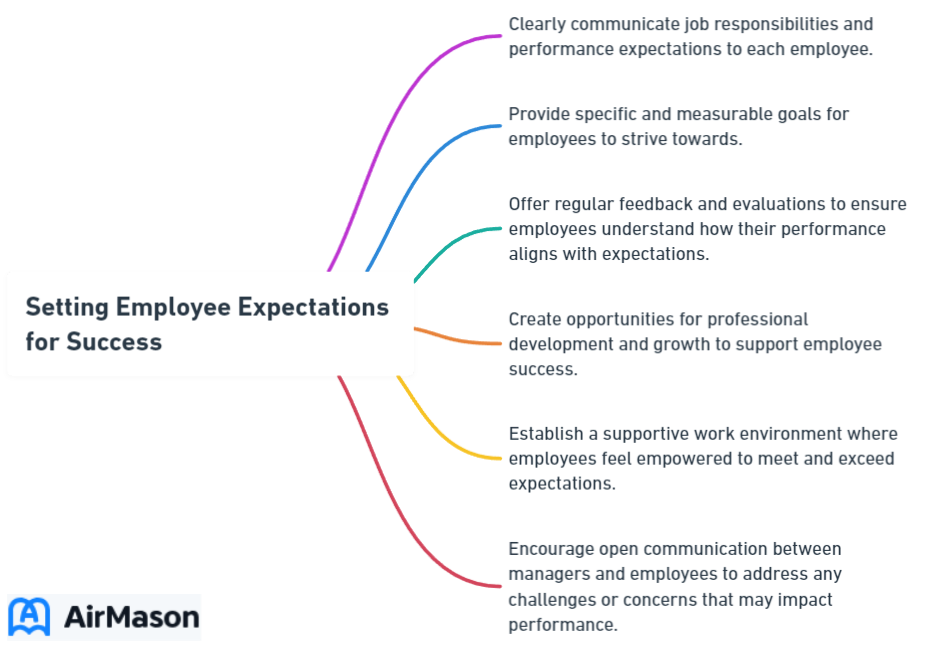
As the world of work constantly evolves, understanding and meeting employee expectations has become a crucial factor in determining business success. In 2024, gone are the days when employees only sought a stable job with a decent paycheck. Today, modern employees value respect, trust, purpose-driven work, and growth opportunities. So, how can employers adapt to these changes and set employee expectations for success? Let’s dive in and explore the key strategies for meeting the ever-changing expectations of the modern workforce.
Key Takeaways
- Understanding and meeting employee expectations is essential for retention of top talent.
- Establish a strong company culture with core values, inclusivity & diversity, effective onboarding & training processes to foster engagement and performance.
- Recognize achievements through recognition programs, competitive benefits & perks to motivate employees and create an engaging workplace.
Understanding Employee Expectations in the Modern Workplace
Attracting and retaining top talent in today’s highly competitive business landscape hinges on meeting employee expectations, as any employer expects loyalty from their workforce. Employees now want:
- to be respected
- to be paid what they deserve
- to feel the trust of their colleagues
- job security
- a chance to learn new skills and better use their abilities
Managers play a pivotal role in managing employee expectations and setting and maintaining employer expectations from day one. By providing a supportive work environment, offering growth opportunities, and establishing open communication, managers can meet employee expectations and contribute to a positive employee experience.
Failure to meet employee expectations can be perceived as unfair and unprofessional, leading to decreased engagement, productivity, and increased employee turnover. Hence, employers need to comprehend and adapt to the evolving expectations of the modern workforce, ensuring they understand what an employee expects and making certain employees feel valued and empowered to give their best.
Employee Definition
The “employee definition” refers to the precise delineation of an individual’s professional status within an organization. This classification involves a comprehensive assessment of an individual’s role, responsibilities, and contractual agreements with the employer. The “employee definition” serves as a crucial framework, outlining the rights, obligations, and benefits associated with the employment relationship. Organizations often establish clear criteria to determine who qualifies as an employee, considering factors such as work hours, supervision, and the nature of the work performed. Understanding the “employee definition” is fundamental for both employers and workers, as it sets the foundation for legal, financial, and operational aspects of the professional engagement.

The Shift in Employee Expectations
Over the past decade, there has been a significant shift in employee expectations, with a greater emphasis on:
- Meaningful work
- Work-life balance
- Congenial company culture
- Professional growth
Studies have shown that meaningful work is correlated with employee engagement, motivation, job satisfaction, and general well-being. As a result, employees now seek work that aligns with their values, provides a sense of purpose, and allows them to make a positive contribution.
Additionally, a positive company culture influences employee expectations by fostering engagement, providing clarity, and enhancing the overall experience, which in turn attracts top talent. In this ever-evolving job market, it is more important than ever for employers to stay ahead of these shifts and adapt their policies and practices accordingly to attract and retain the best talent.
Employer’s Role in Meeting Expectations
Employers significantly contribute to setting employee expectations by creating a supportive work environment, providing growth opportunities, and promoting open communication. To ensure new employees understand their responsibilities, employers should initiate the conversation early in the recruitment process, utilize job descriptions to delineate duties and expected results, and reiterate expectations during interviews. An employee handbook can also be a valuable resource in this regard.
In addition, offering opportunities for career development and training can have a significant impact on both motivating and retaining employees, providing a competitive advantage for organizations that do so. By actively addressing employee expectations and adapting to the changing landscape of the modern workplace, employers can foster a positive and inclusive environment that enables employees to thrive.
Building a Strong Company Culture

Modern employees, who understand the importance of feeling a sense of belonging and being part of something larger, tend to be more satisfied and stay longer in organizations with a strong company culture. A company’s culture influences every aspect of an organization, from employee engagement and performance to overall business success.
To build a strong company culture, employers must clearly define their values and create an inclusive, diverse workplace. This not only helps employees understand the organization’s mission and goals but also fosters a sense of purpose and belonging.
Defining Your Company Values
The establishment of a strong company culture relies heavily on the definition of company values. Articulating a company’s core values and mission can foster a sense of identity and community among employees. Some effective strategies for defining company values include:
- Brainstorming with team members to gain input and perspectives
- Allowing the mission to naturally define the values
- Asking pertinent questions to clarify and refine the values
Leadership plays a significant role in defining company values. Leaders can ensure that employees have faith in the company’s mission by:
- Convening the executive leadership to collaboratively discuss and establish the values
- Demonstrating the values through their words and deeds
- Supporting the team in upholding the values
Fostering Inclusivity and Diversity
A positive company culture hinges on inclusivity and diversity. Employers must actively promote and support these values to create an environment where employees feel valued, respected, and included. Fulfilling our commitment to diversity, equity and inclusion (DEI) is an important goal. Regular calibration of the performance review process can help control for bias in this process..
Although many organizations have committed to advancing DEI in the workplace, there is still work to be done. A 2021 survey conducted by JUST Capital revealed discrepancies between employers’ perception of DEI progress and the reality experienced by employees. By continually reassessing and refining their efforts, employers can foster a more inclusive and diverse workplace that benefits both employees and the organization as a whole.
Effective Onboarding and Training Processes

Efficient onboarding and training processes are crucial to secure employee retention and engagement, assuring new hires feel supported and valued from the start. A well-structured onboarding process helps new employees quickly acclimate to their roles and the company culture, reducing turnover rates.
To ensure new employees understand their roles and responsibilities, employers should clearly communicate expectations during the onboarding process. By doing so, employees can better comprehend their roles and obligations, resulting in heightened engagement, efficiency, and decreased conflict.
Streamlining the Onboarding Process
Helping new employees quickly adapt to their roles and the company culture, hence reducing turnover rates, necessitates streamlining the onboarding process. Employers can achieve this by:
- Focusing on orientation and paperwork completion
- Establishing connections between new hires and managers or teams
- Providing comprehensive training
- Furnishing necessary resources and tools
Additionally, leveraging technology in the onboarding process can provide several benefits:
- Save time
- Enhance the employee experience
- Simplify onboarding forms and documentation By creating a structured and consistent onboarding experience, organizations can help new hires hit the ground running and set them up for success.
Continuous Learning Opportunities
Continual learning opportunities are key to enhancing employees’ professional growth and job satisfaction. In fact, 39% of young employees declare that they have acquired knowledge in the past 30 days which they can employ to improve their job performance.
To create continuous learning opportunities for employees, organizations can:
- Cultivate a culture of continuous learning
- Introduce corporate mentorship programs
- Devise plans for continuous learning
- Provide mentoring opportunities
- Routinely check in with employees regarding their career development objectives
By investing in the development of their workforce, employers not only retain top talent but also build a more skilled and productive team.
Setting Clear Performance Expectations

The establishment of clear performance expectations aids in setting clear employee expectations, allowing employees to better understand their roles and responsibilities. This leads to heightened engagement, productivity, and diminished conflict. When employees understand what is expected of them, they are more likely to achieve or surpass these expectations.
Establishing clear performance expectations has several benefits, including:
- Facilitating communication and collaboration within teams
- Ensuring that everyone is on the same page and working towards the same goals
- Improving overall team performance
- Contributing to a more harmonious and productive workplace.
Utilizing SMART Goals
The use of SMART goals in setting performance expectations is an efficient method to ascertain that expectations are:
- Specific
- Measurable
- Achievable
- Relevant
- Timely
By establishing goals that satisfy these criteria, employees possess distinct objectives to strive for, can monitor their advancement, and comprehend how their performance will be appraised.
Implementing SMART goals also helps align employee goals with organizational objectives, encourages responsibility, and enables efficient performance assessment and feedback. By providing employees with a clear framework for goal setting, employers empower them to take ownership of their work and contribute to the success of the organization.
Regular Check-ins and Feedback
Frequent check-ins and feedback play a critical role in addressing issues, offering guidance, and fostering employee growth and development. By conducting one-on-one meetings with employees on a weekly basis, managers can ensure that employees are on track to meet their goals and address any concerns or challenges they may be facing.
To provide constructive feedback during regular check-ins, managers should:
- Formulate a strategic plan for success
- Maintain a positive attitude
- Solicit feedback
- Provide precise and actionable feedback
- Furnish feedback in real-time
- Foster active involvement from employees
By engaging in open and honest communication, managers can help employees grow professionally and personally, ultimately contributing to a more engaged and productive workforce.
Empowering Employees with Autonomy and Flexibility

Evidence suggests that granting employees autonomy and flexibility leads to increased job satisfaction, engagement, and productivity. In today’s dynamic work environment, employees desire control over their work and the ability to determine when, where, and how their work is accomplished.
By providing employees with autonomy and flexibility, employers demonstrate their trust in their workforce and create an environment where employees feel valued and motivated to contribute their best efforts. This not only leads to increased job satisfaction but also contributes to a more engaged and productive team.
How to Find Employees
In today’s competitive job market, understanding how to find employees is crucial for the success of any organization. Employers can leverage various strategies to identify and attract top talent. Utilizing online job boards, social media platforms, and professional networking sites are effective ways to connect with potential candidates. Additionally, fostering relationships with recruitment agencies and attending industry-specific events can broaden the pool of prospective hires. By strategically combining these methods, businesses can enhance their recruitment efforts and ensure they find employees who not only meet but exceed their expectations.
Encouraging Employee Input
Numerous benefits are associated with encouraging employee input in decision-making processes, such as:
- Strengthening the bond between employees and the organization
- Boosting morale and overall employee engagement
- Fostering collaboration and communication
- Resulting in more favorable decision outcomes and business growth.
Employee input contributes to a sense of ownership and responsibility by:
- Energizing employees to take responsibility for their tasks and strive for success
- Fostering a sense of accountability
- Encouraging career growth and development
By actively involving employees in decision-making processes and valuing their input, employers can create a more inclusive and collaborative work environment.
Embracing Remote Work and Flexible Schedules
For employees to achieve a better work-life balance, which enhances overall well-being and job satisfaction, it’s necessary to embrace remote work and flexible schedules. By offering flexible scheduling options, employers enable employees to:
- Work during the hours they are most productive
- Have more control over their work-life balance
- Reduce commuting time and expenses
- Accommodate personal commitments and responsibilities
This can result in increased productivity and job satisfaction.
To successfully implement remote work and flexible schedules, employers must:
- Establish clear policies and guidelines
- Invest in technology to facilitate remote work and communication
- Foster open and effective communication among employees
- Assess the appropriateness of flexible working hours for each role
By embracing remote work and flexible schedules, modern business employers can cater to the changing expectations of the modern workforce and create a more satisfied and engaged team.
Recognizing and Rewarding Employee Achievements

Acknowledging and rewarding employee achievements is key to retaining and engaging top-notch professionals. Demonstrating appreciation for employees’ hard work and contributions not only motivates them to continue striving for excellence but also fosters a positive and inclusive work environment.
Implementing recognition programs and offering competitive benefits and perks are effective ways for employers to acknowledge and reward employee accomplishments, thus contributing to a more satisfied and engaged workforce.
Implementing Recognition Programs
The implementation of recognition programs can cater to employees’ desire for acknowledgment and appreciation. These programs can include:
- Bonuses
- Written praise
- Verbal praise
- Formal and informal recognition
- Peer-to-peer recognition
- Leader-to-team recognition
By fostering a culture of recognition and promoting the importance of acknowledging and appreciating each other’s efforts, employers can create an environment where employees feel valued and motivated to contribute their best efforts. This not only leads to increased job satisfaction but also contributes to a more engaged and productive workforce.
Offering Competitive Benefits and Perks
Providing competitive benefits and perks – for instance, professional development opportunities, wellness programs, and flexible work options – aids in attracting and retaining exceptional talent. In today’s competitive job market, providing employees with additional benefits and perks beyond the standard salary and benefits package can set an organization apart and make it an employer of choice.
By investing in their employees’ well-being and professional growth, employers not only demonstrate their commitment to employee success but also contribute to a more satisfied and engaged workforce.
Summary
In conclusion, setting employee expectations for success in 2024 requires employers to adapt to the changing landscape of the modern workplace. By understanding and addressing employee expectations, building a strong company culture, implementing effective onboarding and training processes, setting clear performance expectations, empowering employees with autonomy and flexibility, and recognizing and rewarding employee achievements, employers can create an environment where employees feel valued, engaged, and motivated to contribute their best efforts. By investing in the success of their workforce, organizations can ensure their own success in the competitive business world of 2024.
Employee Pledge of Commitment Sample
In crafting an effective organizational culture, providing an “Employee Pledge of Commitment Sample” is crucial. This document serves as a tangible expression of mutual expectations between the employer and employees, outlining the standards and values that both parties commit to upholding. A well-crafted “Employee Pledge of Commitment Sample” not only sets clear guidelines but also fosters a sense of shared responsibility and dedication, creating a positive and collaborative work environment. This tool becomes an essential aspect of aligning individual goals with the overarching mission of the organization, promoting a unified and committed workforce.
Frequently Asked Questions
What are the employee expectations?
Employees are expected to adhere to behavior, performance, and work tasks and outcomes set by their company’s leadership or management team, either formally in an employee handbook or job description or informally during meetings or 1-1 discussions.
What is the example of work expectations?
Employers typically expect employees to be reliable, respectful, and hardworking, and to demonstrate effective communication, teamwork, and punctuality. Additionally, employers often expect employees to take initiative on new projects, come up with ideas to benefit the company, and contribute to the work group’s productivity.
How can employers build a strong company culture?
Employers can create a strong company culture by clearly defining their values, promoting inclusivity and diversity, and creating an encouraging work environment.
How can employers empower employees with autonomy and flexibility?
Employers can empower employees by providing them with control, allowing them to decide when and how to do their work, and including their input in decision-making.
What are some examples of recognition programs that can be implemented to acknowledge employee achievements?
Recognition programs for employees can include bonuses, written praise, verbal praise, formal recognition, informal recognition, peer-to-peer recognition, and leader-to-team recognition.